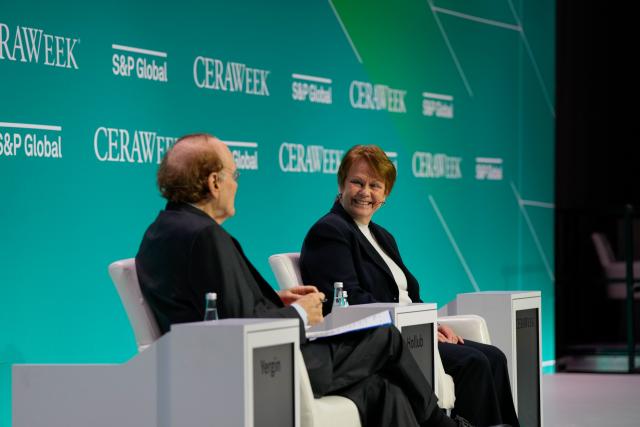
S&P Global Vice Chairman Daniel Yergin chats with Occidental Petroleum Corp. CEO Vicki Hollub on March 8 during CERAWeek by S&P Global in Houston. (Source: CERAWeek/Twitter)
HOUSTON—Shale producers are facing supply chain challenges as they shift plans to grow production, instead of original plans by some to hold steady, to meet growing demand amid geopolitical turmoil and pandemic recovery.
“We’re in a really dire situation here,” Occidental Petroleum Corp. CEO Vicki Hollub said March 8 during CERAWeek by S&P Global, referring to challenges that include supply chain issues in oil country tubular goods, sand and other materials. “We’ve never faced a scenario where we need to grow production, when actual supply chains not only in our industry but every industry in the world [are] being impacted by the pandemic.”
Add to this difficulty finding qualified people to safely and quickly start up rigs.
“Nobody really anticipated needing to grow significantly, and so that’s the challenge now,” she said. “If you didn’t plan for growth, you’re not going to be able to achieve growth today.”
Some shale players, counting on continued improvement in oil demand as the world recovers from pandemic woes, have already stepped up activity, while others await signals from investors who demand capital discipline.
The industry is challenged to overcome supply chain woes as the energy crisis and years of weak oil and gas investment call for action to meet today’s rising energy demand.
Meanwhile, crude oil prices have soared to $124/bbl as sanctions against oil and gas imports from Russia, one of the world’s biggest energy producers, adds another element to volatility and tests capital discipline.
Thinking Ahead
U.S. President Joe Biden on March 8 announced a ban on all imports of Russian oil and gas, taking aim at the country’s economy for its invasion of Ukraine. He warned that U.S. prices at the pump, which the AAA said averaged $4.173 nationwide, could rise further.
“I think it makes sense in the short term. It sends a message to Vladimir Putin about what’s going on in Ukraine,” ConocoPhillips CEO Ryan Lance said of the U.S. ban on Russian oil imports.
Speaking during a separate session, Lance warned that thoughts should be on the medium- and long-term as well as what this means for energy and national security.
“You need to think about it in the context of more than a few months. Heaven forbid this lasts a year or more, we need to start thinking about the implications of that,” Lance said. In addition to operations in the Lower 48 and Alaska, ConocoPhillips has assets in other parts of the world. “Unfortunately, we’ve seen occasions when you don’t manage energy security well as a country or region, this is the implication.”

Unlike Europe, reliance on Russian crude in the U.S. is low. Data from the Energy Information Administration (EIA) show the U.S. imported 199,000 bbl/d of Russian crude and 473,000 bbl/d refined products in 2021, Reuters reported. Russian crude imports in the U.S. reached a record high in 2021 after hurricanes in the Gulf halted U.S. Mars grade crude production.
That year, U.S. consumption of petroleum and other liquids was nearly 20 MMbbl/d. The Permian Basin led oil production growth, and new production from the basin is expected to drive overall U.S. crude oil production growth to 12.6 MMbbl/d in 2023.
The EIA said in February it forecasts production in the Permian region to average 5.3 MMbbl/d this year and rise to average 5.7 MMbbl/d in 2023.
Eyeing Growth
The Permian Basin is the only basin in the U.S. expected to see significant growth, but it might not be easy. Looking back to the 2016 downturn, Hollub pointed out how the rig count bounced back from a low of about 125 rigs to 490, while production surged to 4.8 MMbbl/d from about 2 MMbbl/d.
A key difference between now and then is today’s low inventory of drilled but uncompleted wells, she said. Rig counts have increased, she added, but not significantly. “We’ve got to offset decline now from almost a 5 million barrels a day level versus the offset decline from a 2 million barrels a day level. So, the challenge is pretty significant here to get back to growth in the Permian and that’s the only basin that’s going to grow in U.S. oil production.”
Hollub sees challenges ahead for Permian Basin production growth.
“A lot of people are thinking that maybe 800,000 to a million barrels a day growth year-over-year for the Permian. We don’t see that happening,” Hollub said.
CERAWeek 2022 Coverage:
- Energy Execs at CERAWeek Call Out Vilification of Oil and Gas
- Permian Basin to Play Critical Role in Global Energy Security, Exxon Mobil CEO Says
- Chevron’s Wirth Reaffirms 1 Million-barrel Daily Permian Basin Production Target
- EQT, Chart Industries, Tellurian Execs: US LNG Can Save the World
- Pioneer, ConocoPhillips, Chesapeake Execs Eye Single-digit Growth in US Shale
Capital discipline is seen as another impediment to growth. Oil and gas companies have prioritized dividends and share buybacks, returning capital to shareholders, instead of pouring money into production growth.
Investors see capital discipline as “essentially no growth,” Hollub said, adding Occidental views capital discipline as making sure every dollar invested delivers the most return on capital employed that it can.
Occidental, which in February said it raised its quarterly dividend to 13 cents per share, has positioned itself to break even at less than $40/bbl oil.
“Cash flow growth would only be to support dividend growth and share repurchases,” Hollub said. “That model really delivers the best value over time.”
Lance said the industry can’t lose sight of returns and must think ahead about future production, views on the commodity price market and what is needed to generate desired returns for the business. “Remember, whatever we start doing today it doesn’t get produced for 12 to 18 months from today.”
The industry, he said, is ramping up. ConocoPhillips is among them.
“This industry is going to grow this year, probably 900,000 barrels a day on the crude oil and condensate side,” he said, adding similar growth could also come next year. “And that’s without sort of the commodity prices that we’re seeing today. I think you’re going to see the industry responding to this. We’ve got the same problem that we’ve always had. Inflation is hitting us. Supply chains are hitting us. So, the cost of doing business is certainly going up.”
Recommended Reading
PHX Minerals’ Borrowing Base Reaffirmed
2024-04-19 - PHX Minerals said the company’s credit facility was extended through Sept. 1, 2028.
SLB’s ChampionX Acquisition Key to Production Recovery Market
2024-04-19 - During a quarterly earnings call, SLB CEO Olivier Le Peuch highlighted the production recovery market as a key part of the company’s growth strategy.
BP Restructures, Reduces Executive Team to 10
2024-04-18 - BP said the organizational changes will reduce duplication and reporting line complexity.
Matador Resources Announces Quarterly Cash Dividend
2024-04-18 - Matador Resources’ dividend is payable on June 7 to shareholders of record by May 17.
EQT Declares Quarterly Dividend
2024-04-18 - EQT Corp.’s dividend is payable June 1 to shareholders of record by May 8.






